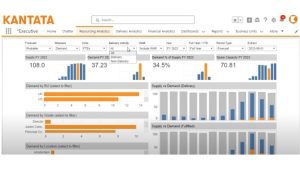
The announcement also signals a change in how Kantata will reveal SX updates. Historically, Kantata has announced releases that coincided with major Salesforce releases, specifically in Spring, Summer and Winter. They will now roll out minor updates more frequently and announce major changes. This is a similar cadence to Kantata OX.
On this change of cadence, Sarah Edwards, Chief Product Officer, Kantata, noted, “We want to take much more of a content-driven approach to our releases so that we are ultimately not only getting things to our customers faster. But also, we can make sure that from a quality perspective, we’re delivering things as and when they’re ready. We are going to be looking at some content in a different time box.”

Edwards commented, “Kantata SX Embedded Analytics is a testament to our commitment to redefining how professional services organizations harness the power of data. By addressing the limitations of traditional operational reporting, we empower organizations to navigate complex dimensions and uncover strategic insights through interactive, visually rich analytics.
“The arrival of these powerful analytics in our Salesforce-native solution, Kantata SX, heralds a new era of tailored intelligence, fostering a dynamic approach to making more informed decisions and propelling businesses toward unprecedented success.”
Three analysers
This update sees a relaunch and update of the three analysers that Kantata has previously announced. Each analyser delivers users with a deeper understanding of their data within customisation dashboards that contain a mix of relevant charts. The three analyser updates in this release are:
- Resourcing Analyzer: takes resource planning to the next level, with FTE modelling of supply and demand across multiple dimensions, including skills, roles, grade, and location.
- Delivery Analyzer: provides deep insight into services engagements, examining trends and performance across portfolios and individual engagements.
- Financial Analyzer: enables more accurate global P&L reporting, with point-in-time exchange rates and tracking of forecast consistency over time.
So what has changed? I asked Edwards that question.
“There are two key differences. One is from a functional perspective. We have now truly embedded the analyzers into the application. Before, you had to log on separately through Tableau. Now, as part of the application, it’s really seamless in terms of having access to those dashboards and even embedding them into some key pages within the application and also enhancing some of the capabilities.”
Those new capabilities include forecast evolution. Embedded within the business unit page in Kantata, it allows the user to see how the business unit is performing against the forecast and how the forecast has changed over time. Users can drill down to see what factors have driven any variance. The forecast evolution dashboard is part of the Financial Analyzer module.
Edwards continued, “The second part is that it is a truly embedded part of our application.”
Not only is the application embedded, but the license is, too. It means that when customers buy the analysers, the price includes the license for the embedded Tableau element. Previously, users had to purchase and install Tableau separately. Now, the whole installation is carried out within the Kantata SX update.
Powerful embedded analytics
Each analyser includes rich data visualisations in various chart forms. They are grouped into customisable dashboards that allow users to investigate, drill down and surface further insights from their data. I asked Edwards how users were able to customise the dashboards.
She replied, “Other solutions, like Certinia, have gone down the Einstein route. It’s not that easy to customise. One of the benefits we see with Tableau is it’s very easy for us to help customers, add to it, surface custom fields, or change the dashboard. Tableau is a pretty powerful tool, able to support custom fields or dimensions is a lot easier.”
Those custom fields can be within the Salesforce Org but not yet from third-party data sets. Using the Tableau embedded license limits what third-party data is accessible.
Another advantage is that businesses can also see trend information across KPIS. Customers can track metrics such as revenue, cost, margin, supply vs. demand, utilization, delivery usage, slippage, engagement status, and risks. To achieve this, users can capture point-in-time extracts of their data for further analysis. One customer has been able to see how their revenue forecast is changing. They were able to identify that it was a single account responsible for pushing out forecasts. They were then able to take mitigating action.
I asked Edwards about this capture of data and whether it had an impact on data storage and, therefore costs. Edwards replied, “We have some best practice recommendations and solutions for customers that ultimately manage that sort of disk space basis. Obviously, yes, it’s a consideration.”
Getting closer to Salesforce
This update is a change for the better from how the analysers used to work. Historically, customers could use either Tableau or Power BI to power the analyser. Kantata still supports a connector to Power BI, to continue using that as a central data warehouse. What this update has done is brought the analysers closer to the users and within their flow of work. It means that they no longer need to switch to a different application, the insights are surfaced where they work.
The change also means that Kantata expects more users to pick up the analysers. Edwards acknowledged that the number of users adopting the analysers to date is “relatively small”. With the new simplified licensing model and the embedded nature of the solution, Edwards is seeing greater interest already and expects more to adopt it.
Organisations can see how one customer, Transform UK, is using the analyser to deliver more precise, comprehensive, and resilient forecasts for improved business planning. Woods is speaking about their experience in a webinar on Tuesday, April 30th, 2024, at 11:15 AM Eastern Standard Time. (Registration required).?
Nick Brisoux, Senior Director, Product Management at Tableau, Salesforce, said, “At Tableau, we are proud to collaborate with innovative partners like Kantata, who are pushing the boundaries of business intelligence. Kantata SX Embedded Analytics combined with Tableau’s advanced functionality empowers organizations to tap into the full potential of their data to drive better and faster decision making.”
Pricing and availability
Pricing for the analysers is based on a percentage of ARR. Customers can also choose to implement one, two or three analysers. Some customers that use Kantata SX mainly for its resourcing capabilities will probably just want the resourcing analyser. Others who use the full breadth of the PSA solution may wish to buy one, two or three of the solutions. According to Edwards, the price per analyser reduces as more are purchased.
Looking forward, I asked Edward what success would look like. She replied, “We want to sell this to every Enterprise SX customer. We think every enterprise customer needs more sophisticated reporting, needs to be able to see trends over time, etc. We want to sell that to every new SX customer. We’re also planning to upsell that to our existing customers. I would think that we will have upsold to 70% – 80% of our customers over the next two years.”
What about Artificial Intelligence
Unlike its competitors, there is little mention of AI from Kantata. Edwards explained what differentiates the Kantata approach, saying, “We have taken a very different approach. We think that this provides much more power and flexibility and ease of use over traditional Einstein.”
I asked Edwards what is on the roadmap for Kantata around AI.
She answered, “I think the intent is that the power of Tableau gives us a leading solution where we can accelerate AI. If you look at Tableau, they’re starting to really invest in AI capabilities. We are currently looking to say, how do we now leverage the power of that platform to deliver AI as part of this?”
Enterprise Times: What does this mean
Kantata has reinvigorated its analysers. Importantly, it is no longer an add-on capability but one that is easier for customers to purchase, install, and implement. The dashboards are prebuilt, which means that the time to value is very short, and with Kantata offering training around the customisation of the dashboards, it does not take long.
What is curious is that Kantata has held off on leveraging AI to further enhance the insights as yet. It will be interesting to see how quickly it does so. Certainly, embedding these analytical dashboards within the application makes it easier for customers to adopt. Still, it would be an AI assistant to take this further, providing more insights and further assistance with the subsequent actions. It will be interesting to see how Kantata develops these analysers now that the architecture is optimal.
The change of update cadence is sensible. The challenge for the Kantata SX team has always been shoehorning multiple updates into the bi-annual releases. The more flexible approach will enable Kantata to deliver updates when they are ready rather than on a specific date. Smaller updates can also roll out faster and without such a big fanfare.
The balance it will need to strike is having an update of note with enough of a cadence to spark attention.

























